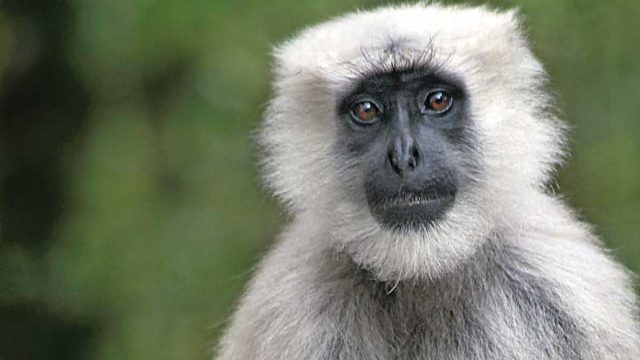Binsar Wildlife Sanctuary is a small protected area, enclosing only 47.04 sq km. However, because the sanctuary lies over heavily forested hill terrain, at altitudes ranging from 3,000 to 8,000 ft, its size belies the ease of movement within. The forest cover is mostly rhododendron and oak at higher altitudes and chir pine at the lower levels. Binsar is home to leopards, ghoral, kakar, wild boar, monkeys, Himalayan black bears, jackals, Indian red fox and porcupines. Though sightings here are occasional, and usually in ones and twos, one does get to see the odd animal, even the elusive leopard. On the other hand, around 200 species of resident and migratory birds have been recorded within its boundaries. Still, most visitors come to Binsar for mountain views and bracing weather, not wildlife.
There is one entry gate for tourists, at Ayarpani, located on the southeast edge, and only one road, climbing in a northwesterly direction to terminate at the Forest Rest House (FRH), near the core zone.
TIP Book your guide at the TRH or at the sanctuary gate the evening before
Entry Indians ₹150; Foreigners ₹650 Vehicle Entry ₹250 Timings Sunrise-sunset, open throughout the year
THINGS TO SEE AND DO
Walks in the Forest
Unlike many other parks in the plains, jeep or elephant safaris are not the means for exploration here. Walking is the only means available to explore Binsar, and in many ways the best way to experience wilderness areas. The sanctuary is crisscrossed with many trails, some relatively wide and well-trodden, others barely discernible. All walks are up and down hillsides and valleys; some are quite steep and long and can tax the stamina of the unfit. However, they are extremely enjoyable: the forests are pristine and shady for the most part, and very thick in some places.

Mountain Views
The stunning views of the snow-clad Greater Himalayan mountain range is truly mind-blowing and a big draw at Binsar. The 300-km lineup stretches all the way into Nepal and includes some of the celebrated giants: Kamet, Mana, Gauri Parbat, Hathi Parbat, Nanda Ghunti, Trishul, Maiktuli, Mrigthuni, Nanda Devi, Panvali Dwar, Machhapuchhare Nanda Devi East, Nanda Khat, Chhanguchh, Nanda Kot, Hardeli. The best time to catch the panorama is in March-April or September-October, when the weather is clear. The FRH and Zero Point offer the best views.
Bineshwar Temple
The 16th-century Shiva shrine from which Binsar takes its name is set in a clearing by the road, 6 km from Ayarpani, and can be visited while driving up. It was built by the Chand Rajas, who had their summer capital at Binsar.
WHERE TO STAY
Stay options are available both within and outside the sanctuary. For the walks, or the best mountain views, and if wildlife is the focus of your trip, it is more practical to stay inside.
Within the Sanctuary
KMVN’s Nanda Devi Tourist Rest House (Cell: 08650002537; Tariff: ₹4,900, with two meals) offers panoramic views from the terrace deck, and is a nodal point for many of the walks.
TIP Snowfall in December-January can block the road above the temple and you may have to trek approximately 4 km from there
About 2 km from Ayarpani, Mountain Resort Khali Estate (Tel: 05962-251011, Cell: 09639989902, 09456566685; Tariff: ₹4,900, with breakfast and dinner) has 15 cottages. The Binsar Retreat (Tel: 251024, Cell: 08191920725; Tariff: ₹8,000-10,000, with breakfast and dinner) has luxury tents and cottages. Also inside the sanctuary is the luxurious Mary Budden Estate (Cell: 09810031753, 09711171350; Tariff: ₹19,000, with meals), with gorgeous interiors.

The FRH (Tariff: ₹2,000) offers privacy at a great location in the heart of the sanctuary. Bookings can be made at the DFO, Civil Soyam Forest Division at Almora (Tel: 05962-230229).
Outside the Sanctuary
On the Bageshwar Road, 17 km from Ayarpani, the resort Club Mahindra Binsar Valley Resort (Cell: 08392910580; Tariff: ₹8,000-9,500) has deluxe suites and cottages and sprawling lawns.
Kasaar Jungle Resort (Tel: 251127, Cell: 09997495677; Tariff: ₹4,000-5,500), set in a pine grove, has modern cottages. A little further down on the main road, Kalmatia Sangam Himalaya Resort (Tel: 251101/ 76; Tariff: ₹7,000-12,800) is a stylish property.
The YMCA Campsite (Tel: 251151-54, Cell: 09368002081; Tariff: ₹560 per person, ₹100 per bed) at Pokhratal, has rooms and dormitories, and the Dinapani FRH (Tel: 05962-230229; Tariff: ₹750), on the Almora Road, is as basic as its Binsar counterpart. About 17 km from Ayar pani, at Dhaulachhina, on the eastern fringe of the sanctuary, Binsar Eco Camp (Delhi Tel: 011-65846278; Tariff: ₹4,500, with meals) has tents and cottages.
WHERE TO EAT
If you discount the ragged assortment of dhabas, for variety’s sake, there’s Dolma’s, near the Kasar Devi Temple, which rustles up momos, some greasy chowmein and lemon chicken. In the Binsar area, the eating is where the staying is. Do not expect á la carte menus at Khali or The Binsar Retreat; meals consist of fixed, whole some, mostly Continental and Indian dishes. Khali is vegetarian and also serves Gujarati food.
Outside, nonvegetarian food is easily available. Club Mahindra Binsar Valley Resort lays out a good buffet. Kasaar Jungle Resort has an extensive multicuisine menu. Kalmatia Sangam Himalaya Resort, offers gourmet Indian and inter national cuisine, including Italian, Mediterranean and French is made with organically grown farm produce. They also bake breads and make confectionery.
When to go The sanctuary is open all year round but the best wildlife sightings are from February to April and October-November. March-April is also the time when flowers, especially the rhododendrons, bloom Location In the verdant tracts of Ayarpani, 35 km from Almora Air Nearest airport: Pantnagar Rail Nearest rail: Kathgodam




